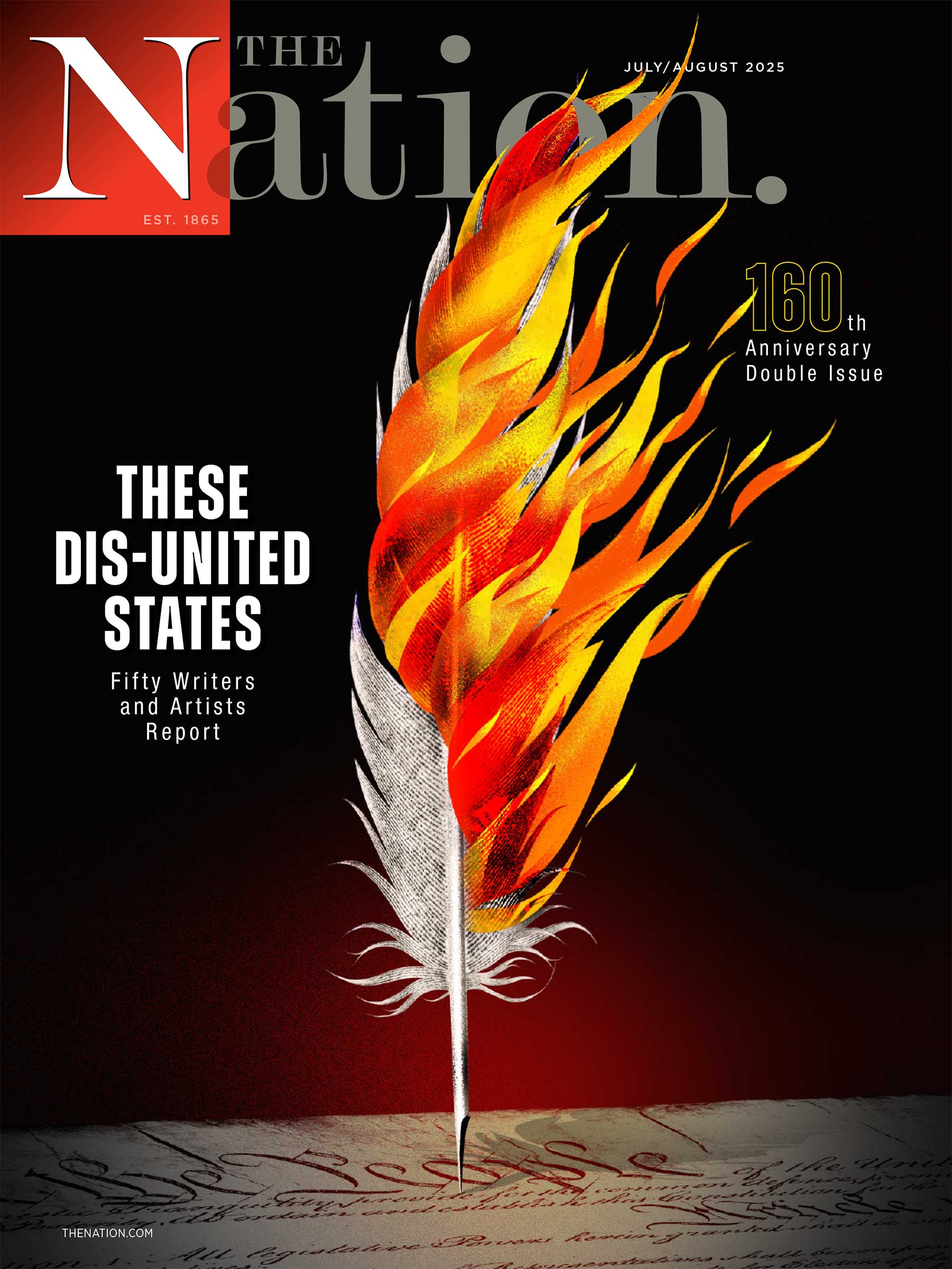The government claims to have put out a rigorous report to back up its opposition to gender-affirming care. But its methods are shoddy beyond belief.

Donald Trump signs the transphobic “No Men in Women’s Sports” executive order in the East Room at the White House on February 5, 2025.
(Andrew Harnik / Getty Images)
On May 1, the Trump administration unveiled a 409-page US Health and Human Services report, which argues that gender-affirming care for minors should no longer be offered. In a press release, the HHS framed the report’s main finding this way: “Despite increasing pressure to promote these drastic medical interventions for our nation’s youth, the review makes clear: the science and evidence do not support their use, and the risks cannot be ignored.”
This finding has been presented as a purely scientific conclusion. The report, we are assured, is “evidence-based” in its approach, and its authors—who remain anonymous—“were chosen for their commitment to scientific principles.” Its ethos is to “follow the gold standard of science, not activist agendas.” And its results are neither prescriptive nor partisan, but neutrally informative: “It is not a clinical practice guideline, and it does not issue legislative or policy recommendations. Rather, it seeks to provide the most accurate and current information available.”
In fact, the report’s case against gender-affirming care is far from scientific. It is ultimately based not on objective evidence, but on subjective values. Quite literally, it is a morally based argument. (This is not to say that it is morally correct.) Thus the report does not, despite what the HHS claims, produce a newly impartial verdict to settle disputes over gender-affirming care for minors. It merely rehearses a familiar one-sided position.
This may not be surprising. But like the 2024 Cass Review that inspired it, the new HHS report will be cited, in months to come, by lawmakers seeking to ban gender-affirming care as solid scientific proof of their position. So it is worth looking closely at what the report actually says, and at precisely how it fails to deliver the objective finding it promises.
In its own words, the report offers an “ethical argument against PMT.” (PMT, or “pediatric medical transition,” is its term for gender-affirming care.) One might think that an ethical argument does not belong in what is supposed to be a literature review. But according to the report, an ethical argument is not out of place because science itself has proven that gender-affirming care is unethical. “It is not ethical,” the report firmly concludes, “to subject adolescents to hormonal and surgical therapies used in PMT.” But has science really proven this?
The authors clearly state what would count as scientific proof that a treatment is unethical. They write: “Informed consent is critically important, but before it is even a consideration, the intervention must be otherwise ethically permissible. For example, before asking whether patients can consent to any proposed intervention, from antibiotics to lobotomy, a clinician must determine whether the intervention has a favorable risk/benefit profile.”
We are given a method here. To prove that a treatment is ethically permissible, one must determine that its risk/benefit profile is “favorable.” Concretely, the authors explain, this means calculating that the treatment’s “expected medical benefits outweigh the expected medical harms.”
Such a calculation can be scientific if it is based on objective evidence. For that to happen, clinical studies must first impartially estimate the “probabilities and magnitudes” of a treatment’s harms and benefits. Once these are known, the benefits and harms can be compared or “weighed” in a straightforward, if not mathematical, manner. Suppose, for instance, that a new antibiotic is being evaluated. Clinical studies have shown that it has a high probability of significantly reducing the infection that it targets. They have shown, as well, that in a small number of cases, the antibiotic produces discomforting but mild side effects. With this evidence in hand, one can judge in a minimally arbitrary way that the antibiotics’ benefits outweigh its harms—minimally arbitrary because this judgment is clearly based on and guided by impartial scientific evidence. Of course, not all treatment assessments can be as clear-cut as this. The crucial point here is simply that in principle, objective evidence can ground and guide an assessment of whether a treatment is ethical, and that such an assessment can be considered scientifically informed rather than arbitrarily decided.
The report wants us to think that its assessment of gender-affirming care is evidence-based and scientifically informed in just this way. “The claims made here about the probability and magnitude of harms and benefits,” it assures us, “are grounded in the best available evidence.” One thus expects that its weighing of gender-affirming care’s harms and benefits will also be based on evidence.
But the report then admits—albeit quietly, in a footnote—that its calculation is largely not based on scientific evidence. The report does draw estimates of the probabilities of gender-affirming care’s various outcomes from scientific studies. But its assessment of their magnitudes—its claims about how severe or significant those outcomes are—are drawn from what the authors forthrightly characterize as (their understanding of) moral common sense.
Here is the authors’ own admission. In many cases, “the probabilities are known with a high degree of certainty.” But “as for the nature of medical benefits and harms and their relative weights, the Review’s working assumptions cohere with common moral intuition, standard medical judgment as revealed in medical diagnostic criteria, and the outcomes of interest to clinicians and researchers, as well as the law.” So in deciding whether any given outcome counts as a benefit or a harm (“nature”), and in estimating the magnitude of each outcome (“relative weight”), the report relies not on evidence but on assumptions. And these assumptions are drawn not from science but from “common moral intuition,” what the authors think is “standard” or “of interest” for clinicians, and current law.
So the magnitudes of gender-affirming care’s benefits and harms are not known scientifically; they are assumed and intuited. This means that half the relevant evidence is missing, and yet the calculation still takes place. To see what the calculation then looks like, consider the example that the authors offer just after their admission. “For example, the analysis would conclude that a minor improvement in depressive symptoms does count as a benefit but that such a benefit, even if assured, does not outweigh moderate or even low but non-negligible risks of infertility or serious sexual dysfunction, loss of breastfeeding function, or lifelong medical dependency, which the Review considers harms.” We are presented with the “conclusion” that “low”-probability harms such as lost breastfeeding functions are so severe that they outweigh the “assured” but less significant benefit of relieved depression. But how was this conclusion reached, if there is no impartial scientific evidence of the magnitudes of the outcomes in question? It was reached by relying on “moral intuition,” which allows the authors to assume the “relative weights” of the outcomes from the start. The authors assume that lost breastfeeding function is a harm, that its importance is greater than that of relief of depression, and then judge the treatment that produces these effects as unethical on the basis of these assumptions.
Popular
“swipe left below to view more authors”Swipe →
In the report’s own words, the calculation just considered is exemplary of its broader ethical analysis. The overall finding that the harms of the hormone and surgical treatments associated with gender-affirming care outweigh their benefits, and thus render them unethical, is enabled throughout the report not just by science but also by moral intuitions, clinicians’ interests, and what “the Review”—the anonymous authors—“considers harms.” In a word, the finding is based not finally on objective science but on subjective commitments and preferences.
This means that the value of the finding is quite limited. It does not have the standing of a proof or a hard fact. The authors themselves seem to know this. Responding to objections that their overall finding remains uncertain, the authors ultimately resort to pounding the table: “We can be certain in the ordinary sense of ‘certain’ that these interventions cause harm [that their harms outweigh their benefits] even if we do not have ‘high certainty’ evidence in the technical sense employed in evidence-based medicine.”
So what suffices for certainty is not based on science at all. By its own standards, the report provides no objective proof that gender-affirming care is unethical. What it provides instead is an unsubstantiated argument that results in nothing more than a certainty that gender-affirming care is wrong “in the ordinary sense of certain.”
This in a report that promised to “follow the gold standard of science.”
Imyself am not fully certain—scientifically or even in an ordinary way—about whether gender-affirming care is “ethically permissible.” I do believe that such care can be provided ethically, that its benefits can outweigh its harms, and that the ongoing legislative efforts to ban it have been based on gross misrepresentations of its practice and theory, and should thus be rejected. But this is a considered belief, based on what I have so far read and seen, no more or less. (It is worth noting that many have criticized the report’s interpretations of the existing scientific evidence, even in the chapters where the report does try to summarize it.) Unlike the authors of the report, I do not pretend to absolute certainty where I do not really have it.
What I am fully certain about is that the HHS offers no scientific proof that gender-affirming care is unethical. I am certain, as well, that the efforts to present it as containing such proof are deeply misleading if not outright deceitful. Maybe the report is right that our ethical judgments should be based on scientific calculation. Shame, then, that this is not what the report actually gives us.
More from The Nation

Sanford Levinson maintains that a peaceful breakup would be preferable to a divided polity, while Tarence Ray argues that the working class must remain united across state lines.

Given advance warning of an impending war crime, the former cheerleader for the Iraq war decided his priority was to protect his scoop.

Kilmar Abrego Garcia is just the latest example of cases in which the administration is finding the flimsiest of reasons to label undocumented immigrants as “criminals.”









